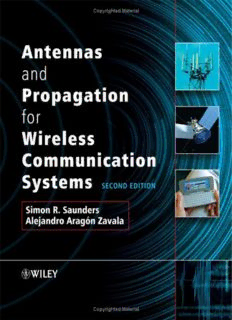Table Of ContentANTENNAS
AND
PROPAGATION
WIRELESS
FOR
COMMUNICATION
SYSTEMS
Second Edition
S R. S ,
IMON AUNDERS
UNIVERSITYOFSURREY,GUILDFORD, UK
ALEJANDRO ARAGO´N-ZAVALA,
TECNOLO´GICOdEMONTERREY, CAMPUS QUERE´TARO, MEXICO
Copyright(cid:1)2007 JohnWiley&SonsLtd,TheAtrium,SouthernGate,
Chichester,WestSussex,PO198SQ,England
Telephone(þ44)1243779777
Email(forordersandcustomerserviceenquiries):[email protected]
VisitourHomePageonwww.wiley.com
AllRightsReserved.Nopartofthispublicationmaybereproduced,storedinaretrievalsystemortransmittedin
anyformorbyanymeans,electronic,mechanical,photocopying,recording,scanningorotherwise,exceptunderthetermsofthe
Copyright,DesignsandPatentsAct1988orunderthetermsofalicenceissuedbytheCopyright
LicensingAgencyLtd,90TottenhamCourtRoad,LondonW1T4LP,UK,withoutthepermissioninwritingofthePublisher.
RequeststothePublishershouldbeaddressedtothePermissionsDepartment,JohnWiley&SonsLtd,
TheAtrium,SouthernGate,Chichester,WestSussexPO198SQ,England,[email protected],orfaxedto(þ44)
1243770571.
Thispublicationisdesignedtoprovideaccurateandauthoritativeinformationinregardtothesubjectmatter
covered.ItissoldontheunderstandingthatthePublisherisnotengagedinrenderingprofessionalservices.Ifprofessionaladvice
orotherexpertassistanceisrequired,theservicesofacompetentprofessionalshouldbesought.
Designationsusedbycompaniestodistinguishtheirproductsareoftenclaimedastrademarks.Allbrandnamesandproduct
namesusedinthisbookaretradenames,servicemarks,trademarksorregisteredtrademarksoftheirrespectiveowners.The
Publisherisnotassociatedwithanyproductorvendormentionedinthisbook.
OtherWileyEditorialOffices
JohnWiley&SonsInc.,111RiverStreet,Hoboken,NJ07030,USA
Jossey-Bass,989MarketStreet,SanFrancisco,CA94103-1741,USA
Wiley-VCHVerlagGmbH,Boschstr.12,D-69469Weinheim,Germany
JohnWiley&SonsAustraliaLtd,42McDougallStreet,Milton,Queensland4064,Australia
JohnWiley&Sons(Asia)PteLtd,2ClementiLoop#02-01,JinXingDistripark,Singapore129809
JohnWiley&SonsCanadaLtd,6045FreemontBlvd,Mississauga,ONT,L5R4J3,Canada
Wileyalsopublishesitsbooksinavarietyofelectronicformats.Somecontentthatappearsinprintmaynotbeavailable
inelectronicbooks.
AnniversaryLogoDesign:RichardJ.Pacifico
BritishLibraryCataloguinginPublicationData
AcataloguerecordforthisbookisavailablefromtheBritishLibrary
ISBN978-0-470-84879-1
Typesetin10/12TimesbyThomsonDigital.
PrintedandboundinGreatBritainbyAntonyRoweLtd,Chippenham,Wiltshire.
Thisbookisprintedonacid-freepaperresponsiblymanufacturedfromsustainableforestry
inwhichatleasttwotreesareplantedforeachoneusedforpaperproduction.
Inmemoryofmyfather.
ForLuke,EmilyandGra´(cid:1)nne.
SimonSaunders
ToLaura,youaremyinspirationandmytruelove.
ToCoco´,MaxiandFimbie.
AlejandroArago´n-Zavala
Contents
PrefacetotheFirstEdition xix
PrefacetotheSecondEdition xxi
1. Introduction:TheWirelessCommunicationChannel 1
1.1 INTRODUCTION 1
1.2 CONCEPTOFAWIRELESSCHANNEL 2
1.3 THEELECTROMAGNETICSPECTRUM 4
1.4 HISTORY 5
1.5 SYSTEMTYPES 7
1.6 AIMSOFCELLULARSYSTEMS 8
1.7 CELLULARNETWORKS 9
1.8 THECELLULARCONCEPT 9
1.9 TRAFFIC 13
1.10 MULTIPLEACCESSSCHEMESANDDUPLEXING 17
1.10.1 FrequencyDivisionMultipleAccess 17
1.10.2 TimeDivisionMultipleAccess 18
1.10.3 CodeDivisionMultipleAccess 18
1.11 AVAILABLEDATARATES 19
1.12 STRUCTUREOFTHISBOOK 20
1.13 CONCLUSION 22
REFERENCES 22
PROBLEMS 23
2. PropertiesofElectromagneticWaves 25
2.1 INTRODUCTION 25
2.2 MAXWELL’SEQUATIONS 25
2.3 PLANEWAVEPROPERTIES 26
2.3.1 FieldRelationships 27
2.3.2 WaveImpedance 27
viii Contents
2.3.3 PoyntingVector 28
2.3.4 PhaseVelocity 28
2.3.5 LossyMedia 28
2.4 POLARISATION 32
2.4.1 PolarisationStates 32
2.4.2 MathematicalRepresentationofPolarisation 32
2.4.3 RandomPolarisation 33
2.5 CONCLUSION 34
REFERENCES 34
PROBLEMS 34
3. PropagationMechanisms 37
3.1 INTRODUCTION 37
3.2 REFLECTION,REFRACTIONANDTRANSMISSION 37
3.2.1 LosslessMedia 37
3.2.2 LossyMedia 41
3.2.3 TypicalReflectionandTransmissionCoefficients 42
3.3 ROUGHSURFACESCATTERING 45
3.4 GEOMETRICALOPTICS 47
3.4.1 Principles 47
3.4.2 Formulation 49
3.5 DIFFRACTION 50
3.5.1 Principle 50
3.5.2 SingleKnife-EdgeDiffraction 51
3.5.3 OtherDiffractingObstacles:GeometricalTheoryofDiffraction 54
3.6 CONCLUSION 59
REFERENCES 59
PROBLEMS 59
4. AntennaFundamentals 61
4.1 INTRODUCTION 61
4.2 PRINCIPLES 61
4.2.1 WhatisanAntenna? 61
4.2.2 NecessaryConditionsforRadiation 62
4.2.3 Near-FieldandFar-FieldRegions 62
4.2.4 Far-FieldRadiationfromWires 63
4.3 ANTENNAPARAMETERS 65
4.3.1 RadiationPattern 65
4.3.2 Directivity 67
4.3.3 RadiationResistanceandEfficiency 67
4.3.4 PowerGain 68
4.3.5 Bandwidth 70
4.3.6 Reciprocity 70
4.3.7 ReceivingAntennaAperture 71
4.3.8 BeamwidthandDirectivity 71
4.3.9 TheFriisFormula:AntennasinFreeSpace 71
4.3.10 PolarisationMatching 72
Contents ix
4.4 PRACTICALDIPOLES 73
4.4.1 DipoleStructure 73
4.4.2 CurrentDistribution 74
4.4.3 RadiationPattern 74
4.4.4 InputImpedance 77
4.5 ANTENNAARRAYS 77
4.5.1 Introduction 77
4.5.2 LinearandPlanarArrays 77
4.5.3 TheUniformLinearArray 77
4.5.4 ParasiticElements:Uda–YagiAntennas 78
4.5.5 ReflectorAntennas 79
4.5.6 MonopoleAntennas 80
4.5.7 CornerReflectors 80
4.5.8 ParabolicReflectorAntennas 81
4.6 HORNANTENNAS 82
4.7 LOOPANTENNAS 83
4.8 HELICALANTENNAS 83
4.9 PATCHANTENNAS 84
4.10 CONCLUSION 85
REFERENCES 85
PROBLEMS 86
5. BasicPropagationModels 89
5.1 INTRODUCTION 89
5.2 DEFINITIONOFPATHLOSS 89
5.3 ABRIEFNOTEONDECIBELS 92
5.4 NOISEMODELLING 93
5.5 FREESPACELOSS 97
5.6 PLANEEARTHLOSS 98
5.7 LINKBUDGETS 101
5.8 CONCLUSION 103
REFERENCE 103
PROBLEMS 103
6. TerrestrialFixedLinks 105
6.1 INTRODUCTION 105
6.2 PATHPROFILES 105
6.3 TROPOSPHERICREFRACTION 108
6.3.1 Fundamentals 108
6.3.2 TimeVariability 111
6.3.3 DuctingandMultipath 111
6.4 OBSTRUCTIONLOSS 113
6.5 APPROXIMATEMULTIPLEKNIFE-EDGE
DIFFRACTION 115
6.5.1 TheDeygoutMethod 115
6.5.2 TheCausebrookCorrection 116
6.5.3 TheGiovanelliMethod 117
x Contents
6.5.4 TestCases 117
6.6 THEMULTIPLE-EDGEDIFFRACTIONINTEGRAL 121
6.6.1 Slope-UTDMultiple-EdgeDiffractionModel 122
6.6.2 TestCase:ComparisonofMultipleModels 126
6.7 DIFFRACTIONOVEROBJECTSOFFINITESIZE 127
6.8 OTHERMETHODSFORPREDICTINGTERRAINDIFFRACTION 129
6.8.1 TheIntegralEquationModel 129
6.8.2 TheParabolicEquationMethod 131
6.9 INFLUENCEOFCLUTTER 134
6.10 CONCLUSION 135
REFERENCES 135
PROBLEMS 137
7. SatelliteFixedLinks 139
7.1 INTRODUCTION 139
7.2 TROPOSPHERICEFFECTS 140
7.2.1 Attenuation 140
7.2.2 RainAttenuation 141
7.2.3 GaseousAbsorption 146
7.2.4 TroposphericRefraction 148
7.2.5 TroposphericScintillation 148
7.2.6 Depolarisation 151
7.2.7 SkyNoise 153
7.3 IONOSPHERICEFFECTS 155
7.3.1 FaradayRotation 158
7.3.2 GroupDelay 159
7.3.3 Dispersion 159
7.3.4 IonosphericScintillation 160
7.3.5 SummaryofIonosphericEffects 160
7.4 SATELLITEEARTHSTATIONANTENNAS 160
7.5 CONCLUSION 161
REFERENCES 161
PROBLEMS 162
8. Macrocells 163
8.1 INTRODUCTION 163
8.2 DEFINITIONOFPARAMETERS 163
8.3 EMPIRICALPATHLOSSMODELS 164
8.3.1 ClutterFactorModels 165
8.3.2 TheOkumura–HataModel 167
8.3.3 TheCOST231–HataModel 169
8.3.4 TheLeeModel 169
8.3.5 TheIbrahimandParsonsModel 170
8.3.6 EnvironmentCategories 171
8.4 PHYSICALMODELS 172
8.4.1 TheAllsebrookandParsonsModel 172
Contents xi
8.4.2 TheIkegamiModel 173
8.4.3 RooftopDiffraction 174
8.4.4 TheFlatEdgeModel 175
8.4.5 TheWalfisch–BertoniModel 178
8.4.6 COST231/Walfisch–IkegamiModel 180
8.5 ITU-RMODELS 181
8.5.1 ITU-RRecommendationP.1411 181
8.5.2 ITU-RRecommendationP.1546 182
8.6 COMPARISONOFMODELS 182
8.7 COMPUTERISEDPLANNINGTOOLS 183
8.8 CONCLUSION 183
REFERENCES 183
PROBLEMS 185
9. Shadowing 187
9.1 INTRODUCTION 187
9.2 STATISTICALCHARACTERISATION 187
9.3 PHYSICALBASISFORSHADOWING 189
9.4 IMPACTONCOVERAGE 189
9.4.1 EdgeofCell 189
9.4.2 WholeCell 192
9.5 LOCATIONVARIABILITY 195
9.6 CORRELATEDSHADOWING 196
9.6.1 SerialCorrelation 197
9.6.2 Site-to-SiteCorrelation 199
9.7 CONCLUSION 205
REFERENCES 205
PROBLEMS 206
10. NarrowbandFastFading 209
10.1 INTRODUCTION 209
10.2 BASEBANDCHANNELREPRESENTATION 209
10.3 THEAWGNCHANNEL 210
10.4 THENARROWBANDFADINGCHANNEL 213
10.5 WHENDOESFADINGOCCURINPRACTICE? 214
10.6 THERAYLEIGHDISTRIBUTION 215
10.7 DISTRIBUTIONOFTHESNRFORARAYLEIGHCHANNEL 218
10.8 THERICEDISTRIBUTION 221
10.9 THENAKAGAMI-mDISTRIBUTION 226
10.10 OTHERFADINGDISTRIBUTIONS 227
10.11 SECOND-ORDERFAST-FADINGSTATISTICS 227
10.11.1 TheDopplerEffect 228
10.11.2 TheClassicalDopplerSpectrum 230
10.12 AUTOCORRELATIONFUNCTION 236
10.13 NARROWBANDMOBILERADIOCHANNELSIMULATIONS 238
10.14 CONCLUSION 239
xii Contents
REFERENCES 239
PROBLEMS 240
11. WidebandFastFading 241
11.1 INTRODUCTION 241
11.2 EFFECTOFWIDEBANDFADING 242
11.3 WIDEBANDCHANNELMODEL 245
11.4 WIDEBANDCHANNELPARAMETERS 246
11.5 FREQUENCYDOMAINEFFECTS 251
11.6 THEBELLOFUNCTIONS 252
11.7 WIDEBANDFADINGINFIXEDLINKS 253
11.8 OVERCOMINGWIDEBANDCHANNELIMPAIRMENTS 254
11.9 CONCLUSION 254
REFERENCES 255
PROBLEMS 255
12. Microcells 257
12.1 INTRODUCTION 257
12.2 EMPIRICALMODELS 257
12.2.1 Dual-SlopeModel 257
12.2.2 TheLeeMicrocellModel 259
12.2.3 TheHar–Xia-BertoniModel 260
12.3 PHYSICALMODELS 262
12.4 LINE-OF-SIGHTMODELS 264
12.4.1 Two-RayModel 264
12.4.2 StreetCanyonModels 265
12.4.3 ITU-RP.1411StreetCanyonModel 267
12.4.4 RandomWaveguideModel 268
12.5 NON-LINE-OF-SIGHTMODELS 270
12.5.1 PropagationMechanismsandCellPlanningConsiderations 270
12.5.2 RecursiveModel 273
12.5.3 ITU-RP.1411Non-Line-of-SightModel 274
12.5.4 Site-SpecificRayModels 275
12.6 DISCUSSION 276
12.7 MICROCELLSHADOWING 277
12.8 NARROWBANDFADING 277
12.9 WIDEBANDEFFECTS 277
12.10 CONCLUSION 278
REFERENCES 279
PROBLEMS 280
13. Picocells 283
13.1 INTRODUCTION 283
13.2 EMPIRICALMODELSOFPROPAGATIONWITHINBUILDINGS 283
13.2.1 WallandFloorFactorModels 283
Description:Antennas and propagation are of fundamental importance to the coverage, capacity and quality of all wireless communication systems. This book provides a solid grounding in antennas and propagation, covering terrestrial and satellite radio systems in both mobile and fixed contexts. Building on the hi

